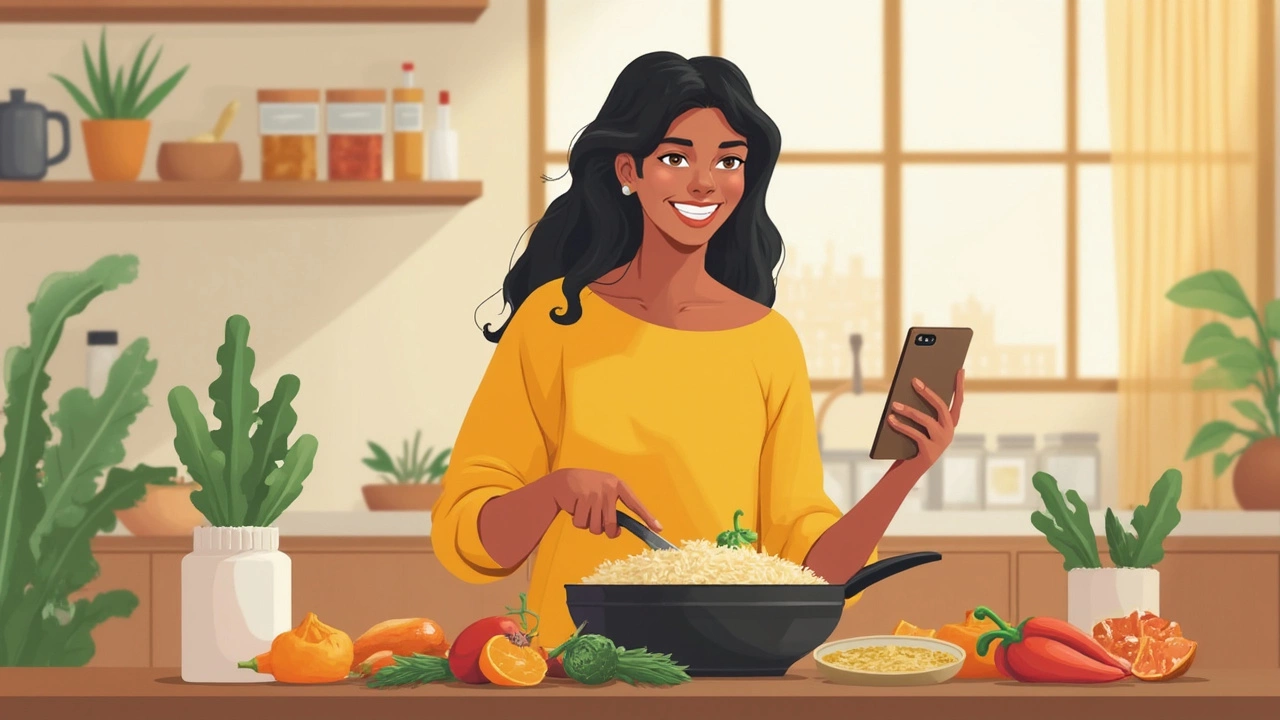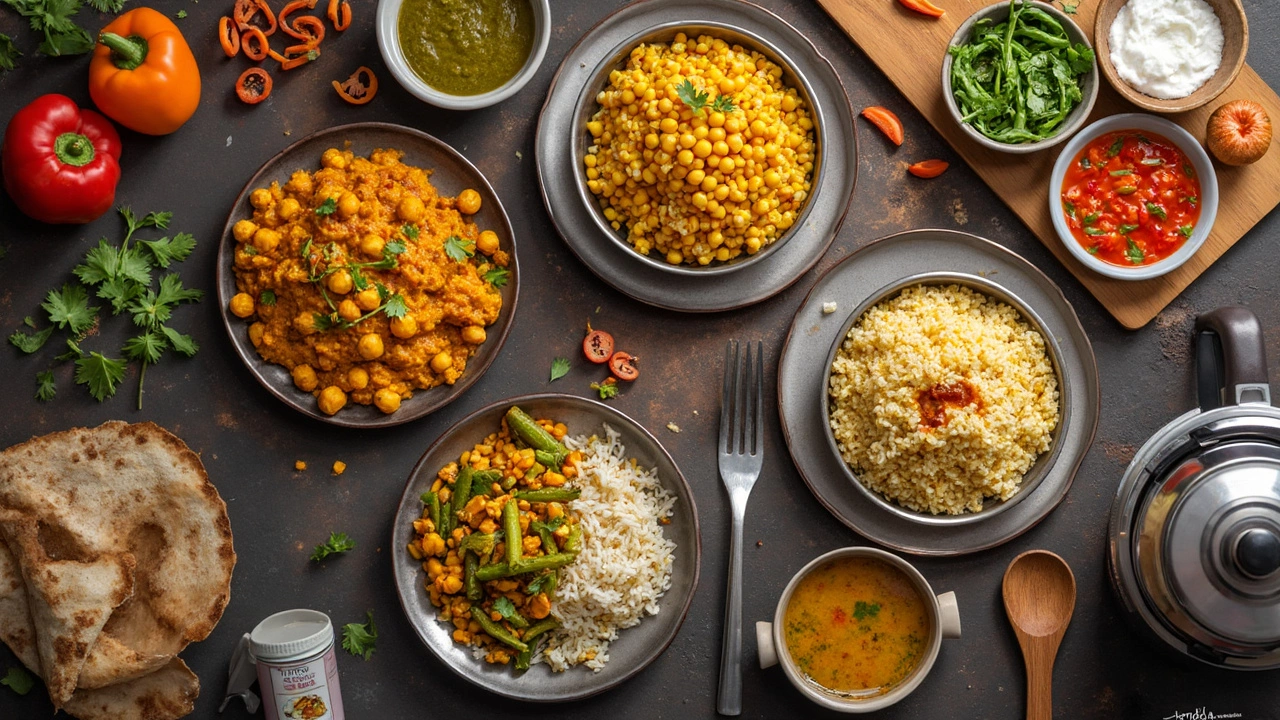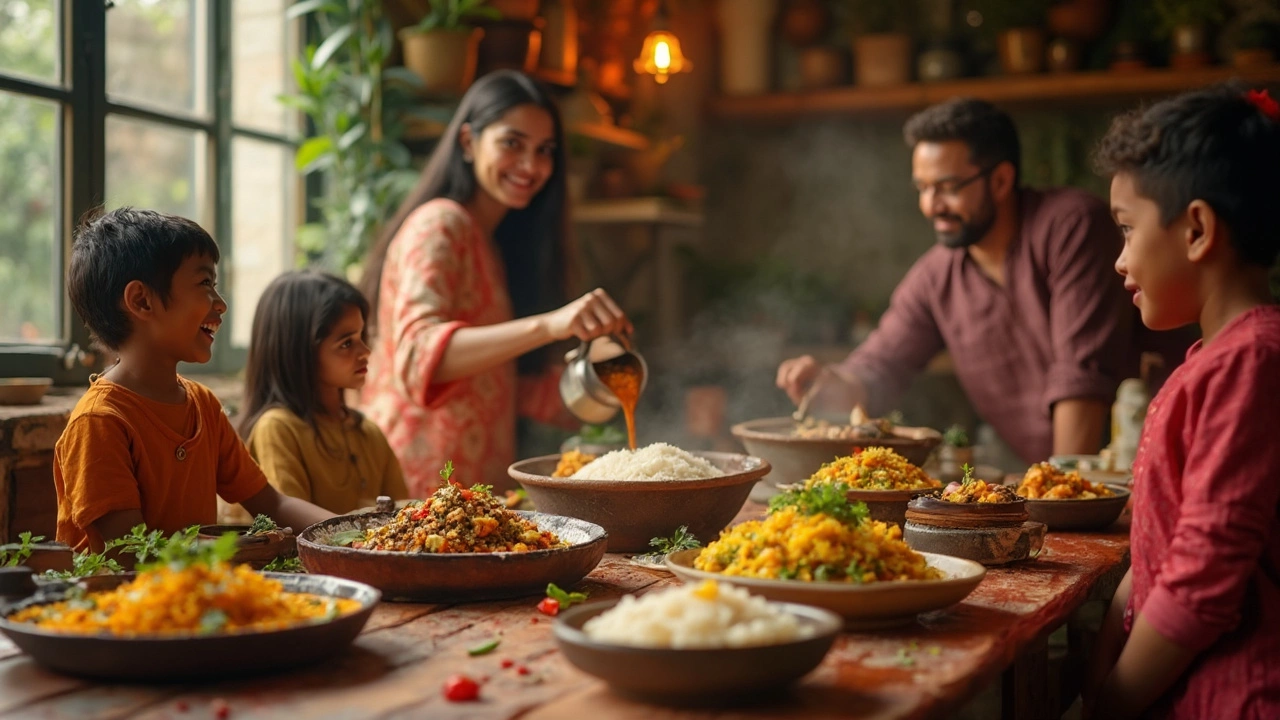If you think great Indian food means hours in the kitchen or a long list of weird spices, think again. Indian dinners can be simple, comforting, and totally doable after a busy day. You don’t need a tandoor, or even a ton of prep—just the right hacks and a handful of ingredients.
One big reason Indian food is awesome for dinner? It’s flexible. Got leftover veggies? Basic pantry spices? You’re set. Most curries and rice dishes start with stuff you already have, like onions, garlic, tomatoes, and a few easy-to-find spices.
There’s also no rule that says dinner has to be fancy. Even street foods like chana masala (chickpea curry) or a simple dal (lentil stew) with rice can be filling and full of flavor—without endless chopping or hours of simmering. So if you’re tired of repeating the same old pasta or sandwiches, Indian food can wake up your dinner routine with real taste and zero fuss.
- Why Indian Food Is Perfect for Dinner
- Staple Ingredients You Actually Need
- No-Fuss Curries to Try Tonight
- Super Simple Rice & Flatbread Sides
- Shortcut Tips for Real Flavor, Fast
Why Indian Food Is Perfect for Dinner
There’s a reason so many people turn to Indian dinner recipes when they want something truly satisfying at night. First, Indian food is all about balance—rich flavors, plenty of textures, and meals that actually keep you full. Whether you’re eating quick Indian meals or slow-cooked dishes, you’ll find proteins, veggies, and carbs all on one plate. It’s way easier than making four separate sides just to feel satisfied.
Another win: Indian food lets you use leftovers and pantry basics without it feeling like "leftover night." Got rice? Turn it into pulao. Leftover chicken or chickpeas? Toss them in a curry. Even that last scoop of plain yogurt works in marinades or quick raita sides. No ingredient needs to go to waste, which is always a plus for weeknight dinners.
If you’re worried about health, here’s some good news. Many healthy Indian dinner ideas skip the heavy cream and frying. Think dals made with lentils, veggie-packed sabzis, and grilled tandoori-style meats. You’re getting fiber, protein, and even antioxidants, often in one quick recipe. According to a 2022 household survey by the Indian National Institute of Nutrition, more than 70% of Indian dinners are based on pulses and vegetables—so these meals are designed to be wholesome, not just filling.
And let’s talk about variety. Even if you’ve never cooked curry before, there’s a flavor profile for everyone—mild coconut gravies, spicy tomato dishes, tangy pickles, even sweet-and-savory combos like paneer with peas. You can keep it mild for the kids, add chili for spice fans, or just go heavy on ginger and cilantro for a fresh spin.
Here’s a quick breakdown of what makes Indian food for dinner a no-brainer:
- Can be made big-batch for leftovers
- Easy to scale for one person or a crowd
- Endless mix-and-match options: one curry, two sides, rice or flatbread
- Good for gluten-free and vegetarian diets without weird substitutes
- Most basics are already in your pantry
If you’re after variety, comfort, and quick wins, easy Indian recipes check every box. No wonder they’re popping up in kitchens around the world right now.
Staple Ingredients You Actually Need
You don’t have to raid special markets or blow your paycheck to make Indian dinner recipes at home. Most classic dishes rely on a core set of ingredients that are probably already in your kitchen. Let’s break down what seriously makes a difference.
- Onions, Garlic, and Ginger: The holy trinity for nearly every easy Indian recipe. Chop or grate them. These kick off the flavor for almost any curry or stir-fry.
- Tomatoes: Fresh is great, canned is totally fine too. Tomatoes add tang and keep sauces from tasting flat.
- Basic Spices: You only need a few: cumin, coriander, turmeric, chili powder, and garam masala. No need to buy them in big packs—most grocery stores have small bottles that last months.
- Dried Lentils & Chickpeas: These are cheap, filling, and shelf-stable. Red lentils (masoor dal) cook super fast, so you can have a hearty Indian food for dinner in under 30 minutes.
- Rice or Flatbread: Basmati rice is the go-to, but regular white rice works for pretty much anything. If you’re feeling up for it, buy some frozen naan or chapati; just heat and serve.
- Neutral Oil: Sunflower, canola, or vegetable oil work well. Ghee (clarified butter) is a bonus for flavor, but not essential.
People wonder if you really need that many spices. Here’s the truth: Most quick Indian meals are built on those same four or five spices, mixed and matched.
| Ingredient | How Long It Lasts | How Often You’ll Use It |
|---|---|---|
| Red Lentils | 1 year (dry pantry) | Weekly |
| Garam Masala | 6-12 months (sealed jar) | Very often |
| Onions | 3-4 weeks (cool, dry place) | Pretty much every dinner |
| Basmati Rice | 6 months (sealed) | Any time you need a side |
Stock your pantry with these basics, and you can whip up loads of healthy Indian dinner ideas without running to the store. Once you’ve got them, mixing up new recipes is just a matter of picking your veggies or protein and spicing them up right.

No-Fuss Curries to Try Tonight
Curry doesn’t have to mean complicated. There are easy Indian recipes that take less than 40 minutes from start to finish, start with basic stuff, and taste like something you’d get at your favorite takeout spot. If you have onion, garlic, tomatoes, and some basic spices, you can pull off a solid curry on any weeknight. Here are a few classics you can’t go wrong with.
- Chana Masala – This is a go-to for many because it’s filling, protein-rich, and vegan by default. Canned chickpeas make it even faster. Sauté onion, garlic, and ginger, toss in chopped tomatoes and chickpeas, sprinkle in garam masala and chili powder, and let it bubble for 15 minutes. Boom—done.
- Egg Curry – Perfect when you’re low on groceries but still want something hearty. Hard boil eggs while your curry base (onion, tomato, spices) simmers. Pop the peeled eggs in for five minutes. Serve with rice or any bread—super budget-friendly.
- Palak Paneer – Got frozen spinach? Great. Sauté with garlic, spices, blend smooth, and toss in cubes of paneer (or even tofu). Fresh, vibrant, and surprisingly quick.
- Simple Chicken Curry – Boneless chicken cooks fast. Marinate small pieces in salt, turmeric, and chili powder. Sauté with onions, tomatoes, and garam masala. Simmer till cooked through. Spoon over rice—family favorite material.
- Moong Dal Tadka – When you’re tired but want something healthy, yellow split moong dal is ready in 20 minutes flat. Boil it; meanwhile, sizzle cumin, garlic, and chili in a spoon of oil, then pour over the dal. Comfort in a bowl.
Curious how these really stack up in the average kitchen? Here are the average prep and cook times for these Indian dinner recipes—with pantry ingredients assumed.
| Curry | Prep Time (min) | Cook Time (min) |
|---|---|---|
| Chana Masala | 10 | 20 |
| Egg Curry | 10 | 20 |
| Palak Paneer | 10 | 15 |
| Simple Chicken Curry | 10 | 25 |
| Moong Dal Tadka | 5 | 20 |
With these options, there’s really no excuse to default to takeout. These Indian food for dinner staples are proof that dinner can be bold, comforting, and actually relaxing to make.
Super Simple Rice & Flatbread Sides
No great Indian dinner recipe is complete without the perfect side. You don’t need to be a chef for this—just a few tricks and really basic ingredients. Let’s talk about the real reason Indian meals are so satisfying: rice and flatbreads like roti or naan.
First up, rice. Basmati is the classic, but honestly, any variety works. For weeknights, skip frying onions and just rinse your rice, toss it in a pot with water and salt, and simmer until done. Want more flavor? Throw in a bay leaf or a pinch of cumin seeds while it cooks. You instantly get that restaurant vibe at home.
For a twist on plain rice, try jeera rice (that’s cumin rice). All you do is sizzle a teaspoon of cumin seeds in hot ghee or oil for 30 seconds, then toss in the cooked rice, mix, and warm through. Takes 5 extra minutes but tastes like you put in real effort.
Now, about flatbread. Store-bought naan or frozen parathas are a busy cook’s best friend, especially if you don’t feel like kneading dough at 7 p.m. But if you do want to try making roti, just mix whole wheat flour with enough water to form a soft dough. Roll into flat circles and cook on a hot pan for about a minute per side. That’s it—no rising or fancy wait time.
Here’s a quick look at common Indian sides and what you’ll need:
| Side | Main Ingredients | Time (mins) |
|---|---|---|
| Plain Rice | Rice, Water, Salt | 15-20 |
| Jeera Rice | Rice, Cumin, Ghee/Oil | 20-25 |
| Naan (store-bought) | Naan, Butter (optional) | 5 |
| Roti | Atta (wheat flour), Water | 20 |
The best part? These quick Indian dinner recipes go with anything—dal, curry, or even a leftover stir-fry. No bread maker or rice cooker required. That’s real kitchen freedom.

Shortcut Tips for Real Flavor, Fast
Trying to pull off easy Indian recipes during a busy week? The trick is locking down real flavor—without getting buried in prep work. Here are tricks that actually work in home kitchens, no extra stress required.
- Buy ginger-garlic paste. Most Indian dinners start here, but chopping is a pain. Ready-made pastes save you at least 10 minutes and taste just as good in sauces, curries, and marinades.
- Pre-mixed masalas are lifesavers. Garam masala, chana masala, or pav bhaji mixes pack a punch. They’re cheap, authentic, and let you skip measuring out six different spices. But check labels: some mass-market brands add too much salt or fillers.
- Use canned tomatoes and cooked chickpeas. There’s no shame—almost every home cook in India does it, especially on hectic nights. Canned tomatoes add depth to curries, and canned chickpeas turn chana masala into a true quick Indian meal.
- Batch-cook your onions. Most recipes want golden-brown onions, but that takes forever. Cook a big batch once a week and keep a jar in the fridge. Just scoop some out for instant curry base.
- Don’t skip fresh finishes. Even simple Indian dinner recipes jump in flavor if you add chopped cilantro, a squeeze of lemon, or sliced green chilies right before serving. Those tiny touches pull everything together fast.
Worried about keeping it healthy? A 2023 nutrition snapshot of homemade Indian cuisine showed that when you make meals at home, you’re likely to use less oil and salt compared to restaurant versions. Check out how homemade and restaurant numbers stack up:
| Dish | Homemade Avg. Calories | Restaurant Avg. Calories |
|---|---|---|
| Dal Tadka | 190 | 310 |
| Chana Masala | 220 | 355 |
| Paneer Curry | 280 | 410 |
Bottom line: keep things simple, use smart shortcuts, and your Indian food for dinner will taste fresh—and still be on the table fast.
